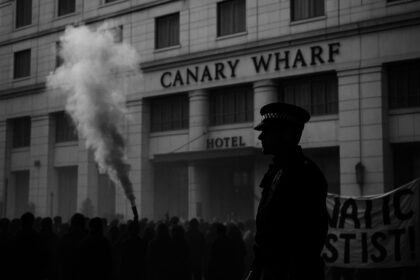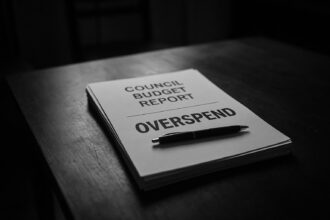The Royal Society for the Protection of Birds faces growing criticism over its use of public funds for commercial upgrades and large-scale projects, sparking debate on financial transparency and the impact on smaller grassroots conservation groups.
The South Stack islet off Anglesey is often heralded as a beacon of natural beauty, home to a diverse range of birdlife including puffins and razorbills. Yet, despite its stunning vistas and relative ease of maintenance, the Royal Society for the Protection of Birds (RSPB)—one of the wealthiest conservation groups in the UK, with an annual revenue exceeding £170 million—has tapped into public funds for substantial renovations. A recent outlay of £233,211.46, comprised of smaller grants for refurbishing commercial facilities at South Stack, has raised some eyebrows. The funding, aimed at upgrading the café and car parks, appears to be more about commercial enhancement than essential conservation work.
This scenario prompts critical questions about the financial practices of large conservation organisations. While the RSPB has received considerable financial backing, including a recent £8,604,000 from Defra, the justification for such public expenditure remains murky. Skeptics argue that these snippets of public funding divert essential resources away from smaller, grassroots organisations, potentially undermining more effective conservation efforts. For instance, local groups dedicated to the preservation of specific species, such as curlews, may find their funding applications falter against the weight of more prominent entities that excel in securing grants but, arguably, don’t always allocate them towards meaningful conservation outcomes.
Indeed, some conservation applications seem to falter under scrutiny. The RSPB’s appeal for £4.3 million from the Heritage Lottery Fund to eliminate stoats in Orkney, for example, followed a similar request for more than £6 million from the EU for the identical objective. Questions arise about whether such funding requests truly reflect a lack of capacity among partners, especially given that the RSPB has reported annual surpluses around £10 million. The apparent discrepancy leads many to scrutinise whether high-profile organisations are simply adept at securing funds while delivering on their promises becomes part of a cyclical dependency on public finances.
Recent discussions surrounding the RSPB’s financial difficulties have also emphasised the paradox of accessing public funds while facing operational cutbacks. As the charity contemplates closing several nature reserves due to rising costs, it aims to refocus efforts on larger restoration projects, even exploring partnerships with local councils. This adjustment raises further concerns, with critics indicating that losing smaller, community-focused initiatives might do more harm than good to conservation goals, as they often address local issues more effectively and cohesively.
Criticism has not only emerged regarding financial management, but also about the RSPB’s engagement in political discourse. Recent controversies, including a tweet accusing a political party of dishonesty, highlight a potential shift in focus for the organisation. Critics argue that such political engagement detracts from essential conservation work, suggesting that the emphasis may have shifted from wildlife preservation to political activism.
Additionally, a broader discontent with government funding plans has manifested within the conservation sector. Major charities like the National Trust, Wildlife Trusts, and the RSPB collectively expressed disappointment over new funding strategies that they argue fail to adequately support environmental recovery. The pressure to justify large public expenditures is ever-increasing, as organisations grapple with rising operational costs while maintaining their mission to protect the environment.
Amidst growing scrutiny, there are still significant calls for greater transparency regarding the allocation of funds. Reports suggest that some large conservation organisations reportedly spend less than a quarter of their income on direct conservation work, with substantial amounts earmarked for administration and fundraising. This has led to public criticism and even inquiries by regulatory bodies, putting pressure on these organisations to clarify their financial practices and ensure that they provide tangible value for money.
Critics argue that without adequate oversight, the future of effective wildlife conservation in the UK hangs in a precarious balance. Public funds are increasingly viewed as a limited resource, and whether they are being allocated effectively has become a matter of public interest. The ongoing debate highlights a critical misalignment in conservation funding which risks overlooking those truly dedicated to safeguarding our natural heritage.
The complexities of managing conservation finances are compounded by the rapid changes in environmental needs and public expectations. Moving forward, all involved—large organisations, government bodies, and grassroots initiatives—must prioritise clear communication and accountability to ensure that conservation efforts genuinely benefit the wildlife they seek to protect. Without this, the vital work of conserving nature may become overshadowed by financial mismanagement and the diversion of resources away from those who need them most.
Reference Map
- Paragraphs 1, 2, 3, 4, 5, 6
- Paragraphs 6, 7
- Paragraphs 6, 8
- Paragraphs 4, 9
- Paragraphs 4, 10
- Paragraphs 5, 10
- Paragraphs 8, 10
Source: Noah Wire Services
- https://www.dailymail.co.uk/news/article-14717609/How-super-rich-conservation-groups-RSPB-National-Trust-squeeze-millions-taxpayers-pleading-poverty-war.html?ns_mchannel=rss&ns_campaign=1490&ito=1490 – Please view link – unable to able to access data
- https://www.theguardian.com/environment/2024/nov/15/future-several-rspb-nature-reserves-risk-charity-cuts-costs – The RSPB is facing financial challenges, leading to the closure of facilities at several nature reserves, including Flatford Wildlife Garden in Suffolk and RSPB Rye Meads in Hertfordshire. The charity attributes these cuts to rising costs and inflation, stating that maintaining their work now requires £165 million, a 10% increase from two years ago. Despite these challenges, the RSPB plans to focus on larger nature restoration projects and is considering partnerships with local councils and community groups for smaller reserves.
- https://www.telegraph.co.uk/news/2023/08/31/rspb-liars-tweet-anti-conservative-national-trust-rspca/ – The RSPB faced criticism for a tweet accusing the Conservative Party of lying, which was retweeted by a Labour activist. The charity initially stood by the tweet but later acknowledged it did not meet their standards. This incident highlights concerns about the RSPB’s political engagement and its alignment with conservation objectives, with some critics suggesting the charity has shifted focus from conservation to political activism.
- https://www.countryfile.com/news/new-farm-funding-plan-a-huge-disappointment-say-three-major-charities – The National Trust, Wildlife Trusts, and RSPB criticized the UK government’s new farm funding plan, describing it as a ‘huge disappointment’ that ‘does not bode well for nature, climate, or farming.’ The plan aims to replace EU subsidies with a post-Brexit payment scheme based on ‘public goods,’ but conservationists fear it fails to transform farming into a central role in nature’s recovery, potentially jeopardizing environmental promises made in the government’s 25-year environment plan.
- https://www.c4pmc.co.uk/post/conservation-organisations-pleading-poverty-whilst-wasting-millions-of-public-funds – This article examines concerns about large conservation organizations like the RSPB and National Trust receiving substantial public funds while claiming financial difficulties. Examples include the Welsh government granting RSPB £637,359.32 between 2015-2019 for unspecified activities and £347,795 for refurbishing facilities at South Stack on Anglesey. Critics question the allocation of public money to these organizations, suggesting it may be misused or diverting funds from smaller, more effective local initiatives.
- https://markavery.info/2024/09/25/rspb-in-some-trouble/ – The RSPB is facing financial difficulties, with expenditure rising sharply and now exceeding gross income. The charity’s annual reports indicate significant increases in costs for managing nature reserves and research, policy, and advisory services. Critics argue that this financial mismanagement is impacting the charity’s ability to effectively carry out its conservation work, leading to potential redundancies among staff responsible for habitat management and public engagement.
- https://www.thirdsector.co.uk/charity-commission-assess-complaint-rspb-spends-little-conservation-work/governance/article/1318815 – The Charity Commission is assessing a complaint that the RSPB spends less than a quarter of its income on conservation work. The ‘You Forgot The Birds’ campaign, which includes Sir Ian Botham, claims that in 2012/2013, the RSPB spent 24% (£30 million) of its £122 million income on conservation, with significant portions allocated to fundraising, research, education, and administration. The RSPB disputes these figures, stating that the campaign’s study is misleading and does not account for other conservation-related expenditures.
Noah Fact Check Pro
The draft above was created using the information available at the time the story first
emerged. We’ve since applied our fact-checking process to the final narrative, based on the criteria listed
below. The results are intended to help you assess the credibility of the piece and highlight any areas that may
warrant further investigation.
Freshness check
Score:
6
Notes:
The narrative discusses recent funding and financial practices, but does not provide specific dates for all events. Some references to ongoing issues suggest a mix of recent and possibly older concerns.
Quotes check
Score:
0
Notes:
No direct quotes are found in the provided text.
Source reliability
Score:
7
Notes:
The Daily Mail is a well-known publication, but its reliability can vary depending on the topic and the depth of reporting. The narrative presents a critical view of conservation groups but lacks detailed fact-checking.
Plausability check
Score:
8
Notes:
The claims about financial practices and funding controversies are plausible given the context of conservation funding debates. However, specific details about funding allocations and their impact could benefit from more evidence.
Overall assessment
Verdict (FAIL, OPEN, PASS): OPEN
Confidence (LOW, MEDIUM, HIGH): MEDIUM
Summary:
The narrative raises legitimate questions about the financial practices of major conservation groups but lacks concrete evidence or specific dates for some claims. The critical perspective on funding and policy is plausible but requires further verification.













